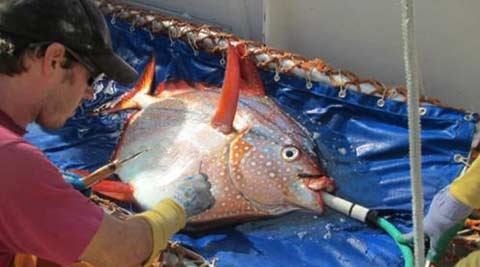In a groundbreaking discovery, researchers have identified the first warm-blooded fish—a giant ‘moonfish’ with fins that flap to generate heat. This remarkable find challenges long-held beliefs about fish physiology and sheds new light on the complexities of life in the deep ocean.

The giant ‘moonfish,’ which measures the size of a car tyre, has long intrigued scientists with its mysterious habits and physiology. Now, with advanced technology and research methods, scientists have uncovered the fish’s remarkable ability to maintain its body temperature above that of the surrounding water.

Unlike most fish that rely on the ambient temperature of their environment, the ‘moonfish’ uses its specialized fins to generate heat. This adaptation allows the creature to thrive in colder waters, giving it a unique advantage in the deep ocean where temperature fluctuations can be extreme.

The discovery of the first warm-blooded fish not only expands our understanding of marine life but also raises questions about the incredible diversity of adaptations that have evolved in the vast underwater world. It emphasizes the need for further exploration and study of the ocean’s depths to unravel the mysteries that lie beneath.

The research findings open doors for further investigations into the fascinating adaptations that marine creatures have developed over millions of years. It also highlights the interconnectedness of ecosystems and the delicate balance that exists between species, each playing a crucial role in the health and sustainability of the ocean environment.
As researchers continue to delve into the secrets of the giant ‘moonfish’ and its warm-blooded capabilities, the discovery becomes a testament to the wonders of nature and the continuous marvels that await us in the unexplored corners of our planet. It underscores the importance of conservation efforts to protect these extraordinary creatures and the fragile ecosystems they inhabit.